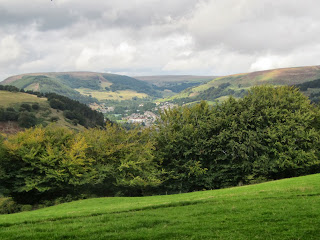South Wales Valleys are B E A U T I F U L !!
 |
| Abertillery Valley from the base of Guardian |
They have everything !!
Coastal and inland scenery unsurpassed anywhere.
Huge beaches and tiny coves.
Tropical temperatures (well this summer, anyway!)
Short walks, long walks, upland walks, flat walks.
The largest miners' memorial in the world.
 |
| Guardian, Six Bells, (tall as Angel of the North, 20 mtrs.) |
Excellent food.

Cream cakes, fresh fruit and veg., even a chocolate factory.
Good pubs with unusual local brews.
Variety of places to stay from camping to luxury hotels.
Waterfalls
Canals
Leaning Tower (more than Pisa)
 |
| Caerphilly Castle, home of the leaning tower |
Cycle paths and off-road tracks

Sheep (not that many cows, but alpacas).
Wide roads with easy driving and narrow roads with passing places.
Cultivated parks and gardens and wild mountainsides and common land.
Steam trains.
Shopping in cities or in small local boutiques and markets.
Towns with free parking.
Wonderful wild flowers and exotic cultivated species.
 |
| Nantyglo Round Tower |
Castles and Manor Houses (ruined and otherwise)
Friendly people willing to chat, and those who are less so, (you get them everywhere).
Industrial heritage.
National and local museums.
Underground experiences with a fully trained coal miner.
Busy places.
Quiet places to be alone to think.
All this
concentrated
within an hour or two's drive.
 |
| View of Kidwelly |
You can travel from Kidwelly in the west to Pontypool in the east in around one and a half hours. But think of all the wonderful places you'll pass by if you do that.
http://www.fieldsintrust.org/Default.aspx









































